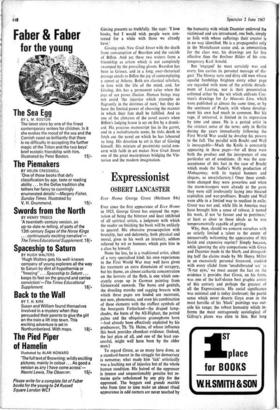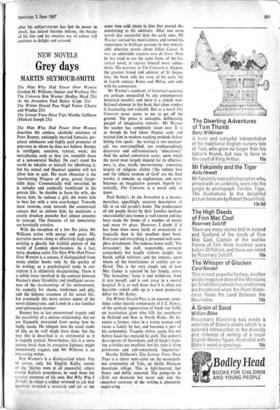Expressionist
OSBERT LANCASTER
Ecce Homo George Grosz (Methuen 84s) Ever since the first appearance of Ecce Homo in 1923, George Grosz has enjoyed the repu- tation of being the bitterest and least inhibited of all satirical artists, a judgment with which the reader on finishing the book will be unlikely to quarrel. His obsessive preoccupation with brutality, lust and deformity, both physical and moral, gives to his work an intensity, seldom relieved by wit or humour, which puts him in a class by himself.
None the less, he is a traditional artist, albeit of a very specialised kind; his own experiences in the First World War may well have given his treatment an extra dimension of savagery, but his theme, an almost cathartic concentration on the horrors of the flesh, is one which con- stantly crops up in German painting from Grunewald onwards. The bums and genitals, the drooling mouths and sagging breasts with which these pages are loaded are recurrent, not new, phenomena, and even his combination of these elements with the stuffiest symbols of the bourgeois Fatherland—the draped lamp- shades, the busts of the All-Highest, the potted palms and the ubiquitous gramophone horn —had already been effectively exploited by his predecessor, Th. Th. Heine, of whose influence this book provides abundant evidence. (Indeed, the last plate of all, and one of the least suc- cessful, might well have been by the older man.)
To regard Grosz, as so many have done, as a standard-bearer in the struggle for democracy is nonsense; what made him 'tick' artistically was a loathing not of injustice but of the whole human condition. His hatred of the oppressor is intense and unquestionably genuine but re- mains quite unbalanced by any pity for the oppressed. The beggars and grands mantes who from time to time make an almost ritual appearance in odd corners are never touched by the humanity with which Daumier endowed the victimised and are introduced, one feels, simply as foils with whose sufferings their creator is in no way identified. He is a propagandist only in the Manichaean cause and, as ammunition for the class war, his drawings are far less effective than the Berliner Bilder of his con- temporary Karl Arnold.
But 'engaged' he most certainly was and every line carries its personal message of dis- gust. The blowsy tarts and dirty old men whose squalid fumblings brighten every other page are regarded with none of the artistic detach- ment of Lautrec, nor is their presentation softened either by the wit which enlivens Coc- teau's drawings for Le Mauvais Lieu, which were published at almost the same time, or by the sentiment of Pascin, with whose develop- ment his own had much in common. But his rage, if universal, is limited in its expression by time and space. He is a period artist in the strictest sense of the term; only in Berlin during the years immediately following the First World War could he develop his powers to the full. The parallel with Brecht and Weil is inescapable—Mack the Knife is constantly appearing in these pages—for all three were both the product and the interpreters of one particular set of conditions. (It was the non- acceptance of this fact in the case of Brecht which made the Sadler's Wells production of Mahagonny, with its topical banners and slogans, so unsatisfactory.) Once these condi- tions changed they were powerless and when the storm-troopers were already at the gates they were still irrelevantly laying into bloated capitalists and war-profiteers. Brecht and Weil were able in a limited way to readjust in exile; Grosz was not and, while life in America may have brought him a sense of release, it turned his work, if not 'to favour and to prettiness,' at least as close to those ideals as he was temperamentally capable of getting.
Why, then, should we concern ourselves with so strictly limited a talent to the extent of unreservedly welcoming the appearance of this lavish and expensive reprint? Simply because, while ignoring the airy comparisons with Goya and Daumier made in the blurb, and disregard- ing half the claims made by Mr Henry Miller in an excessively personal foreword, studded with every cliché from 'unadulterated sex' to `X-ray eyes,' we must accept the fact on the evidence it provides that Grosz, on his form, was one of the half-dozen best graphic artists of this century and perhaps the greatest of all the Expressionists. His social significance was minimal and is today irrelevant; the poetic sense which never deserts Goya even in the most horrific of his 'black' paintings was out- side his range; the robust humanity which in- forms the most outrageously scatological of Gillray's plates was alien to him. But long after his subject-matter has lost its power to shock, has indeed become tedious, the beauty o of his line and his emotive use of colour will continue to delight and astound.



































 Previous page
Previous page